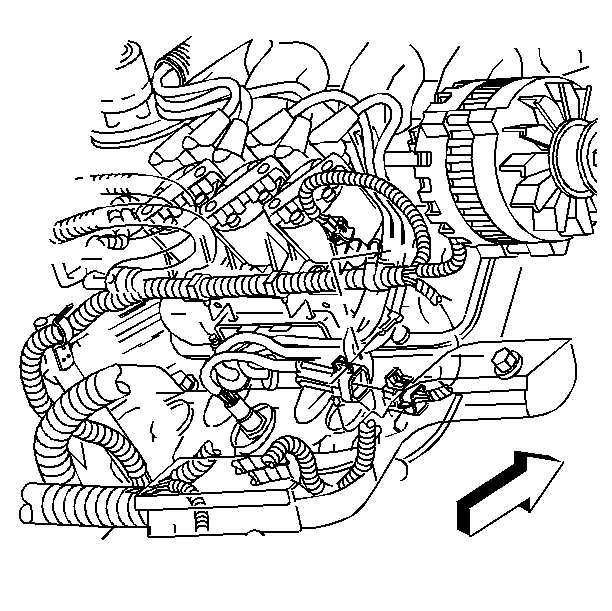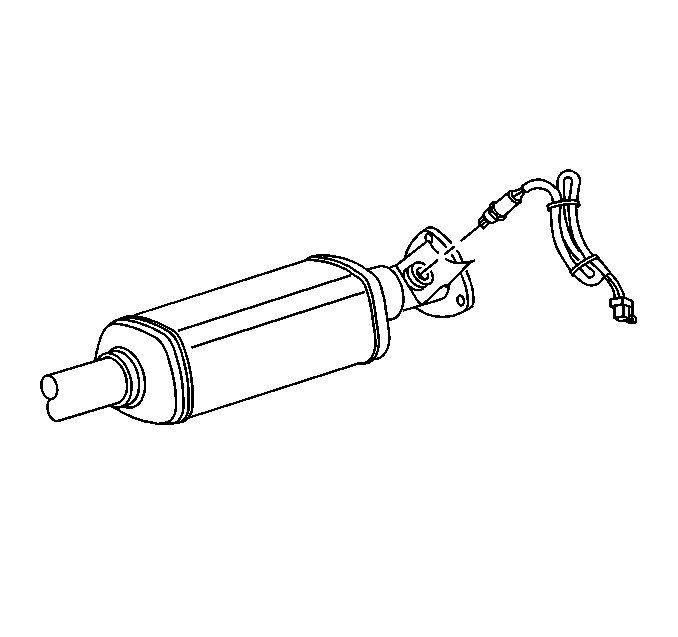Heated Oxygen Sensor Replacement HO2S1
Removal Procedure
Tools Required
J 39194-B heated oxygen sensor wrench
Notice: The Heated Oxygen Sensor (HO2S) and the Oxygen Sensor use a permanently attached pigtail and connector. Do not remove this pigtail from the Heated Oxygen Sensor. Damage or the removal of the pigtail or the connector could affect the proper operation of the sensor.
Take care when handling the HO2S and the O2S. Keep the in-line electrical connector and the louvered end free of grease, dirt, or other contaminants. Also avoid using cleaning solvents of any type. Do not drop the HO2S or the O2S. Do not roughly handle the HO2S or the O2S.Notice: The use of excessive force may damage the threads in the exhaust manifold/pipe.
The heated oxygen sensor (HO2S) may be difficult to remove when the engine temperature is below 48°C (120°F).
- Turn OFF the ignition.
- Disconnect the HO2S 1 electrical connector.
- Carefully remove the heated oxygen sensor.

Important: Remove oxygen sensors with the engine temperature above 48°C (120°F). Otherwise the oxygen sensors may be difficult to remove.
Installation Procedure
- Coat the threads of the HO2S 1 with anti seize compound, or equivalent if necessary.
- Install the heated oxygen sensor.
- Connect the electrical connector.

Important: A special anti-seize compound is used on the oxygen sensor threads. New service sensors should already have the compound applied to the threads. Coat the threads of a reused sensor with anti-seize compound P/N 5613695 or equivalent.
Notice: Use the correct fastener in the correct location. Replacement fasteners must be the correct part number for that application. Fasteners requiring replacement or fasteners requiring the use of thread locking compound or sealant are identified in the service procedure. Do not use paints, lubricants, or corrosion inhibitors on fasteners or fastener joint surfaces unless specified. These coatings affect fastener torque and joint clamping force and may damage the fastener. Use the correct tightening sequence and specifications when installing fasteners in order to avoid damage to parts and systems.
Tighten
Tighten the HO2S 1 to 42N·m (31 lb ft).
Heated Oxygen Sensor Replacement HO2S2
Removal Procedure
Tools Required
J 39194 heated oxygen sensor wrench
The heated oxygen sensor (HO2S) may be difficult to remove when the engine temperature is less than 48°C (120°F). Excessive force may damage the threads in the exhaust manifold or the exhaust pipe.
Notice: The Heated Oxygen Sensor (HO2S) and the Oxygen Sensor use a permanently attached pigtail and connector. Do not remove this pigtail from the Heated Oxygen Sensor. Damage or the removal of the pigtail or the connector could affect the proper operation of the sensor.
Take care when handling the HO2S and the O2S. Keep the in-line electrical connector and the louvered end free of grease, dirt, or other contaminants. Also avoid using cleaning solvents of any type. Do not drop the HO2S or the O2S. Do not roughly handle the HO2S or the O2S.- Turn OFF the ignition.
- Raise the vehicle.
- Disconnect the electrical connector.
- Use the J 39194-B heated oxygen sensor wrench in order to carefully remove the HO2S 2.

Important::
• Remove oxygen sensors with the engine temperature above 48°C
(120°F). Otherwise the oxygen sensors may be difficult to remove. • A special anti-seize compound is used on the heated oxygen sensor
threads. The compound consists of graphite suspended in fluid and glass beads.
The graphite will burn away, but the glass beads will remain, making
the sensor easier to remove. New or service sensors will already have
the compound applied to the threads. If a sensor is removed from an
engine and is to be reinstalled, the threads must have anti-seize compound
applied before reinstallation.
Installation Procedure
- Coat the threads of heated oxygen sensor/catalyst monitor with anti-seize compound GM P/N 5613695, or equivalent if necessary.
- Use the J 39194-B in order to install the HO2S 2.
- Connect the electrical connector.
- Lower the vehicle.

Notice: Use the correct fastener in the correct location. Replacement fasteners must be the correct part number for that application. Fasteners requiring replacement or fasteners requiring the use of thread locking compound or sealant are identified in the service procedure. Do not use paints, lubricants, or corrosion inhibitors on fasteners or fastener joint surfaces unless specified. These coatings affect fastener torque and joint clamping force and may damage the fastener. Use the correct tightening sequence and specifications when installing fasteners in order to avoid damage to parts and systems.
Tighten
Tighten the HO2S 2 (post-catalytic converter) to 42 ±4 N·m
(31 lb ft).
